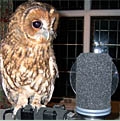 |  | |||||
 | ||||||
Telinga "Stereo DAT" parabolic or dish mic | ||||||
This microphone plus dish setup revolutionised my ability to record birds in the field -- as it would anybody's! It's a powerful mic and very quiet. Not only that, if used with care it gives good stereo ambience around the bird you're focusing on. My only gripe is that it's rather shrill, or bright, at higher frequencies. It's not the ideal mic to use on birds with high, piercing calls like the European Robin or even the Wren, and I've switched to other setups for our english dawn choruses, which are full of tiny shrill singers. At mid and lower frequencies, however, it's excellent. It's not cheap, especially with Swedish VAT at 25%, but once that bullet's been bitten you'll find it's so good at what it's designed to do (pull in the birds) that it never gets left on the shelf.
27 May 2007: I've put some more comments on this mic and a link to the maker's site on the next page.
. . . So, some samples. All are mp3s at 160 kb/s and 44.1 kHz. First off is a Nightingale battling to be heard against a rising dawn chorus. I drove down a tiny country lane at about 4.15 am intending to record a dawn chorus in this wood, and bingo, there was a Nightingale right opposite where I parked, singing on his own. This sample is from some way into the chorus, though before it got really noisy. The Nightingale continued singing for about 45 minutes. Here the Telinga mic is being used without the dish in a vertically upright position on a tripod. (The same bird can be heard recorded with Røde NT1-As on the Røde NT1-A page.) Dawn chorus with nightingale 1.7 Mb
I was lucky with this Cuckoo as another dawn chorus for which I had wrenched myself out of bed at 3 am was turning into something of a non-event. Then 40 minutes into it the Cuckoo flew into the top of the tree directly over where I was standing in the road and sang for the next ten minutes, with a short break for a preen. Every time he cuckoos he bows alternately to left or right. The gobbling cackle at the beginning seems to be the call the bird makes when moving about. Unaided mic again – no dish. Cuckoo 800 kb
Now for some night birds. First is a Nightjar recorded in a large area of forest run by the Forestry Commission. We’d been tipped off by a well-known local expert and bird painter that the nightjars had arrived, as they do every year, and we struck lucky with this one bird who came and sang his rasping song for two minutes in a tree quite nearby. It was odd later that night to hear another call that sounds as if it comes straight from the Costa Rican countryside – where the Nightjar’s cousin, the “cuyeo”, calls just after dark. Here the Telinga is used with dish. Nightjar 750 kb
This is one of a pair of Little Owls whose babies I was recording. By now they had become quite used to my presence and the one here is actually fussing at a fox that’s passing in the middle distance. It’s just before 4 am and a distant dawn chorus can be heard. Telinga with dish. Little Owl 900 kb More Little Owl calls with the Telinga on the Little Owls page. One of the same pair of owls, but with noisy accompaniment. What one goes through to record these creatures – at this stage I was tracking the owls down to their centre of operations. Telinga with dish. Little Owl and cows 600 kb
Dominique Laloux's website Sounds Natural has many more bird song samples made with the Telinga. His site is immaculately organised and the mp3 sample are long, allowing one to really get one's ears around a mic's characteristics. Every entry states the recording equipment used (often the Telinga hitched up to an HHB Portadisc). Dominique is aiming to record all the birds in his area of Belgium, so quite a few European species are represented. As of May 2007 there are 195 entries. Recommended.
| ||||||
powered by owls | ||||||